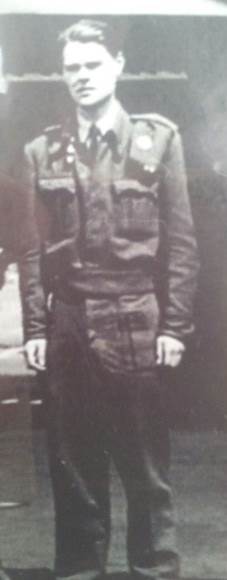Raymond Worrall
• 25 th July 1944
• Sgt – 44 Sqn – Flt Engineer
• Lancaster 1 – ME694 KM-L
• RAF Dunholme Lodge near Lincoln
• Target: Stuttgart

They crossed the Channel near Caen. Flying over enemy territory several aircraft were brought down by flak and others attacked by night fighters. However, once through the enemy defences things began to quieten down. Suddenly there was a large thump from the rear of the aircraft, causing it to go into an uncontrolled steep dive and the skipper gave the order to bail out.
Ray landed in a ploughed field, shaken and bruised but otherwise unharmed. He quickly buried his parachute and began walking away from the area. It was his first time outside of Great Britain. He estimated that Caen was 250 miles to the north-west, so used his escape compass to plot his direction of travel. At dawn Ray found cover under a hedge and slept. Then he used his pen-knife to cut the leg part from his flying boots, so that they resembled shoes, and moved off again at sunset. He walked for several days.
Ray was passed by several people, none of whom paid him much attention, and there were a couple of ‘near-misses’ when he had to take cover as German vehicles, laden with troops, approached. The snacks from his Survival Pack were the only food that Ray had eaten since landing and it was a relief when he was approached by a youth on a bicycle who indicated that Ray should hide under a hedge until he returned for him.
The youth did return, in a car with the local doctor [whose wife came from Bournemouth!], and was taken to a farm where he was offered food and drink. It was there that Ray was reunited with his wireless operator and his bomb-aimer and the ‘helpers’ staged an informal celebration for them with wine stolen from the Germans.
The next day the group was taken by couriers to the edge of a large, dense forest. The French couriers left and the airmen were taken deep into the forest where, to their surprise, over one hundred evaders had been hidden by the French Resistance. The Foret de Freteval, situated about three miles off the road from Chartres to Vendome, near a small village called Villeboute, was to become home for the next few months. In the forest all cooking was done on charcoal fires which made little ‘tell-tale’ smoke. Breakfast consisted of mainly bread [brought in by horse and cart!], butter and coffee; lunch was often vegetable stew, sometimes with meat.
By August 1944, 152 men were hidden in the forest. The ‘furniture’ was made from logs and branches; trees served as notice boards; shelters were made from branches, although a few tents were available. All had to be disguised from the air. There were threats from low–flying aircraft overhead and German convoys that halted at the edge of the forest overnight. A routine existed, sentries were posted and each man kept his personal escape kit on him at all times in case the forest was attacked and he had to make a run for it.
On the 18th August 1944 distant heavy gunfire announced the imminent arrival of a convoy of vehicles driven by British and American personnel. About half of the evaders climbed aboard and were taken to Bayeux in Normandy. After a week in Normandy Ray was returned to London.
Ray Worrall wrote about his experiences in: ‘Escape from France’- Pub Silver Quill – ISBN -1 872939 80 5
